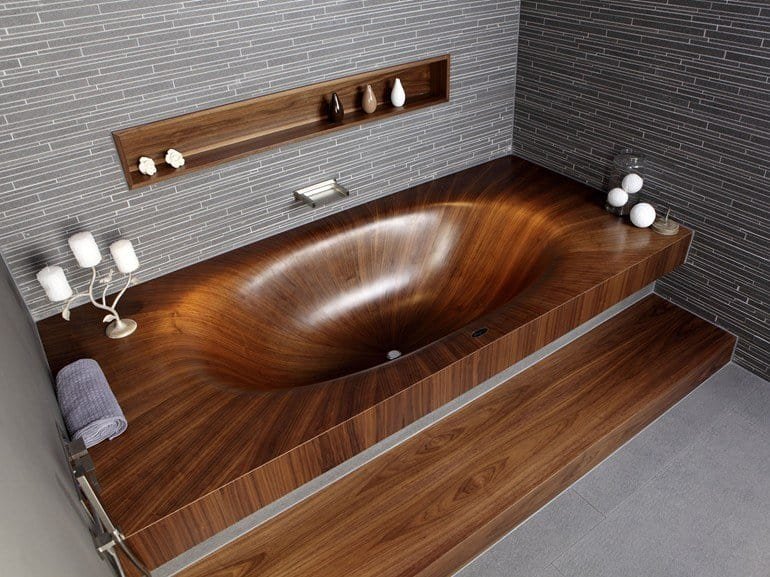Wooden baths are becoming increasingly popular as more people look for ways to enhance their bathrooms with unique, luxurious, and natural elements. These baths offer a beautiful and serene experience that combines the aesthetic appeal of wood with the comfort of a relaxing soak. Unlike conventional ceramic or acrylic bathtubs, wooden baths provide a warm and inviting atmosphere, making them a perfect addition to any bathroom. In this article, we will explore the different aspects of wooden baths, their advantages, types, maintenance, and much more. Whether you’re considering a wooden bath for its look, comfort, or eco-friendliness, this guide will help you understand everything you need to know.
What Are Wooden Baths?
Wooden baths are bathtubs made primarily from wood or wood-clad materials, offering a rustic yet luxurious feel to any bathroom. These baths can be made from solid wood or have a wooden exterior surrounding a more traditional acrylic or fiberglass tub. Wood provides a unique, natural texture that many find soothing and aesthetically pleasing. Most wooden baths are crafted using types of wood that are resistant to water damage, such as cedar, teak, or pine. These materials are chosen not only for their durability but also for their ability to retain heat, ensuring your bath stays warm for a longer period.
Wooden baths come in a variety of shapes and sizes, from large soaking tubs to smaller, more compact designs. Whether you’re looking for a traditional Japanese-inspired tub or a modern freestanding design, there’s a wooden bath to fit every bathroom style. With careful maintenance, a wooden bath can last for many years, providing a unique blend of luxury and comfort.
Advantages of Wooden Baths
Wooden baths offer numerous benefits, making them a popular choice for homeowners looking to create a unique and luxurious bathroom space. One of the primary advantages is their aesthetic appeal. The natural wood finish adds a sense of warmth and tranquility to any bathroom, transforming it into a spa-like retreat. Unlike cold, impersonal materials like metal or ceramic, wood has a rich texture that makes the bathing experience feel more intimate and connected to nature.
Another significant advantage is comfort. Wood is a natural insulator, meaning it helps maintain the warmth of the water for a longer period compared to other materials like acrylic or ceramic. This is especially beneficial for those who enjoy long, relaxing baths. Additionally, wooden baths can be more eco-friendly than their synthetic counterparts. Many wooden bath manufacturers use sustainable wood sources, ensuring that your bath is both beautiful and environmentally conscious.
Durability is also a key benefit of wooden baths. While wood requires some maintenance, a high-quality wooden bath can last for decades, with the wood becoming richer in appearance as it ages. Overall, wooden baths offer a combination of style, comfort, and sustainability that makes them an excellent choice for homeowners looking to elevate their bathroom experience.
Types of Wooden Baths
There are several types of wooden baths available on the market, each offering different features and benefits. The most common type is the solid wood bath, where the tub is made entirely from wood. These baths are typically crafted from high-quality, water-resistant woods such as teak, cedar, or pine. Solid wood baths are known for their luxurious feel, as the wood provides a rich texture and a natural warmth that enhances the bathing experience.
Another popular option is the wooden-clad acrylic bath. In this design, the tub itself is made from a traditional material like acrylic or fiberglass, and it is covered with a wooden exterior. This option combines the benefits of both wood and synthetic materials, providing a durable and low-maintenance tub with the aesthetic appeal of wood. Wooden-clad baths are often more affordable than solid wood baths, making them a popular choice for homeowners on a budget.
Each type of wooden bath has its advantages, depending on your preferences and needs. Solid wood baths are perfect for those seeking a completely natural experience, while wooden-clad acrylic baths offer a more budget-friendly alternative without sacrificing style. Both types are available in a variety of shapes and sizes to suit different bathroom spaces.
How to Care for Wooden Baths
Wooden baths require regular care and maintenance to ensure they remain in good condition over time. The most important step in maintaining a wooden bath is preventing water damage. Wood can absorb moisture, which may lead to warping or rot if not properly sealed. It is essential to apply a high-quality wood sealant or water-resistant finish to protect the surface of the bath. Depending on the type of wood, this may need to be done every couple of years.
Regular cleaning is also crucial. You should avoid harsh chemicals that can damage the wood’s finish. Instead, use mild soap and water to clean the surface of the bath. After each use, make sure to dry the wood thoroughly to prevent any moisture from seeping into the surface. If any mold or mildew starts to appear, it’s important to address it immediately to prevent further damage.
In addition to cleaning and sealing, check the bath periodically for any cracks or signs of wear. Repairing small issues early on can prevent larger problems down the line. With proper care, your wooden bath can last for many years and maintain its beauty.
Wooden Baths vs. Traditional Bathtubs
When deciding between a wooden bath and a traditional bathtub, it’s essential to consider the differences between the two. Traditional bathtubs, such as those made from ceramic, fiberglass, or acrylic, are durable and easy to maintain. They are also typically more affordable than wooden baths. However, they lack the natural warmth and aesthetic appeal that wooden baths offer.
One of the main advantages of wooden baths over traditional bathtubs is the luxurious experience they provide. The natural wood finish not only adds beauty to your bathroom but also enhances the sensory experience of bathing. The warmth of the wood and the soothing texture create a calming environment that traditional materials can’t replicate.
On the other hand, wooden baths require more maintenance than traditional bathtubs. While ceramic or acrylic tubs only need occasional cleaning, wooden baths must be regularly sealed and cleaned to prevent damage from water. If you’re willing to put in the extra effort, a wooden bath can provide a more enriching and unique bathing experience than a traditional tub.
Best Wood Types for Bath Construction
When choosing a wooden bath, it’s important to consider the type of wood used in its construction. Certain woods are better suited for use in bathrooms due to their water resistance and durability. Some of the best wood types for bath construction include cedar, teak, and pine.
Cedar is a popular choice for wooden baths because it is naturally resistant to water and insects. It also has a pleasant scent that can enhance the overall bathing experience. Teak is another excellent option due to its natural oils, which protect the wood from water damage and make it incredibly durable. While it is more expensive than cedar or pine, its longevity makes it a worthwhile investment for many homeowners.
Pine is a softer wood that is often used in wooden-clad acrylic baths. It is more affordable than cedar or teak but still offers a beautiful finish and reasonable durability. When choosing the wood for your bath, consider factors such as the climate in your area, the level of maintenance you’re willing to commit to, and your budget.
Design Ideas for Incorporating Wooden Baths
Wooden baths can be incorporated into various bathroom designs, from modern minimalist spaces to more traditional, rustic bathrooms. One popular design choice is to pair the wooden bath with natural stone elements, such as a stone floor or a stone wall accent. This combination creates a spa-like atmosphere that feels luxurious and serene.
For a more modern approach, consider combining the wood with sleek, minimalist fixtures and clean lines. This can help balance the natural warmth of the wood with a more contemporary aesthetic. Alternatively, you can opt for a more rustic design, where the wooden bath becomes the focal point of the room. Adding wooden shelving, a wooden vanity, or even wooden beams on the ceiling can enhance the natural theme.
Wooden baths can be a striking design feature in any bathroom, so don’t be afraid to get creative and experiment with different styles and materials.
Considerations Before Installing a Wooden Bath
Before installing a wooden bath, there are several considerations to keep in mind. First, make sure that the space in your bathroom is adequate for the size and shape of the bath you’re interested in. Wooden baths are often larger and heavier than traditional bathtubs, so it’s important to ensure your floor can support the weight.
Budget is another important factor. Wooden baths can be more expensive than standard bathtubs, both in terms of initial cost and long-term maintenance. Make sure to factor in the cost of regular maintenance, including sealing and cleaning products, as well as any repairs that may arise.
Finally, consider the level of care you’re willing to dedicate to the bath. Wooden baths require more attention than other types of bathtubs, so it’s important to be prepared for the extra effort involved in maintaining them.
Conclusion
Wooden baths offer a unique and luxurious alternative to traditional bathtubs, with their natural beauty, warmth, and eco-friendly qualities. Whether you choose a solid wood bath or a wooden-clad acrylic option, a wooden bath can enhance your bathroom and provide a relaxing, spa-like experience. While they do require more maintenance than traditional tubs, the comfort, durability, and aesthetic appeal make them a worthwhile investment for many homeowners. With proper care, your wooden bath can last for many years, becoming a beautiful focal point in your bathroom and a place of relaxation for years to come.




